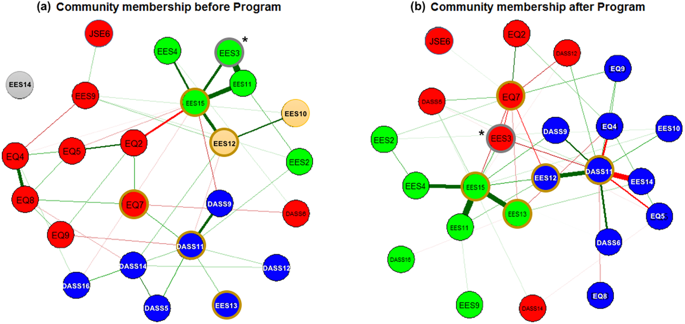Our official English website, www.x-mol.net, welcomes your
feedback! (Note: you will need to create a separate account there.)
Changing characteristics of the empathic communication network after empathy-enhancement program for medical students.
Scientific Reports ( IF 3.8 ) Pub Date : 2018-Oct-10 , DOI: 10.1038/s41598-018-33501-z Je-Yeon Yun 1, 2 , Kyoung Hee Kim 1 , Geum Jae Joo 1 , Bung Nyun Kim 3 , Myoung-Sun Roh 4 , Min-Sup Shin 3
Scientific Reports ( IF 3.8 ) Pub Date : 2018-Oct-10 , DOI: 10.1038/s41598-018-33501-z Je-Yeon Yun 1, 2 , Kyoung Hee Kim 1 , Geum Jae Joo 1 , Bung Nyun Kim 3 , Myoung-Sun Roh 4 , Min-Sup Shin 3
Affiliation

|
The Empathy-Enhancement Program for Medical Students (EEPMS) comprises five consecutive weekly sessions and aims to improve medical students' empathic ability, an essential component of humanistic medical professionalism. Using a graph theory approach for the Ising network (based on l1-regularized logistic regression) comprising emotional regulation, empathic understanding of others' emotion, and emotional expressivity, this study aimed to identify the central components or hubs of empathic communication and the changed profile of integration among these hubs after the EEPMS. Forty medical students participated in the EEPMS and completed the Depression Anxiety Stress Scale-21, the Empathy Quotient-Short Form, the Jefferson Scale of Empathy, and the Emotional Expressiveness Scale at baseline and after the EEPMS. The Ising model-based network of empathic communication was retrieved separately at two time points. Agitation, self-efficacy for predicting others' feelings, emotional concealment, active emotional expression, and emotional leakage ranked in the top 20% in terms of nodal strength and betweenness and closeness centralities, and they became hubs. After the EEPMS, the 'intentional emotional expressivity' component became less locally segregated (P = 0.014) and more directly integrated into those five hubs. This study shows how to quantitatively describe the qualitative item-level effects of the EEPMS. The key role of agitation in the network highlights the importance of stress management in preserving the capacity for empathic communication. The training effect of EEPMS, shown by the reduced local segregation and enhanced integration of 'intentional emotional expressivity' with hubs, suggests that the EEPMS could enable medical students to develop competency in emotional expression, which is an essential component of empathic communication.
中文翻译:

医学生共情增强计划后共情沟通网络的变化特征。
医学生共情增强计划 (EEPMS) 包括连续五次每周课程,旨在提高医学生的共情能力,这是人文医学专业精神的重要组成部分。本研究使用伊辛网络图论方法(基于 l 1 -正则化逻辑回归),包括情绪调节、对他人情绪的共情理解和情绪表达,旨在识别共情沟通的核心组成部分或枢纽,以及变化的情绪。 EEPMS 之后这些中心之间的集成概况。 40 名医学生参加了 EEPMS,并在基线和 EEPMS 后完成了抑郁焦虑压力量表 21、同理心商数简表、杰斐逊同理心量表和情绪表达量表。在两个时间点分别检索基于伊辛模型的共情沟通网络。激动、预测他人感受的自我效能、情绪隐藏、主动情绪表达和情绪泄漏在节点强度和中介性和亲密性中心性方面排在前20%,成为枢纽。 EEPMS 之后,“有意情感表达”成分的局部隔离程度降低(P = 0.014),并且更直接地融入这五个中心。本研究展示了如何定量描述 EEPMS 的定性项目级效果。激动在网络中的关键作用凸显了压力管理在保持同理心沟通能力方面的重要性。 EEPMS 的培训效果表现为局部隔离的减少以及“有意情感表达”与中枢的整合增强,这表明 EEPMS 可以帮助医学生培养情感表达的能力,而情感表达是共情沟通的重要组成部分。
更新日期:2018-10-10
中文翻译:

医学生共情增强计划后共情沟通网络的变化特征。
医学生共情增强计划 (EEPMS) 包括连续五次每周课程,旨在提高医学生的共情能力,这是人文医学专业精神的重要组成部分。本研究使用伊辛网络图论方法(基于 l 1 -正则化逻辑回归),包括情绪调节、对他人情绪的共情理解和情绪表达,旨在识别共情沟通的核心组成部分或枢纽,以及变化的情绪。 EEPMS 之后这些中心之间的集成概况。 40 名医学生参加了 EEPMS,并在基线和 EEPMS 后完成了抑郁焦虑压力量表 21、同理心商数简表、杰斐逊同理心量表和情绪表达量表。在两个时间点分别检索基于伊辛模型的共情沟通网络。激动、预测他人感受的自我效能、情绪隐藏、主动情绪表达和情绪泄漏在节点强度和中介性和亲密性中心性方面排在前20%,成为枢纽。 EEPMS 之后,“有意情感表达”成分的局部隔离程度降低(P = 0.014),并且更直接地融入这五个中心。本研究展示了如何定量描述 EEPMS 的定性项目级效果。激动在网络中的关键作用凸显了压力管理在保持同理心沟通能力方面的重要性。 EEPMS 的培训效果表现为局部隔离的减少以及“有意情感表达”与中枢的整合增强,这表明 EEPMS 可以帮助医学生培养情感表达的能力,而情感表达是共情沟通的重要组成部分。













































 京公网安备 11010802027423号
京公网安备 11010802027423号